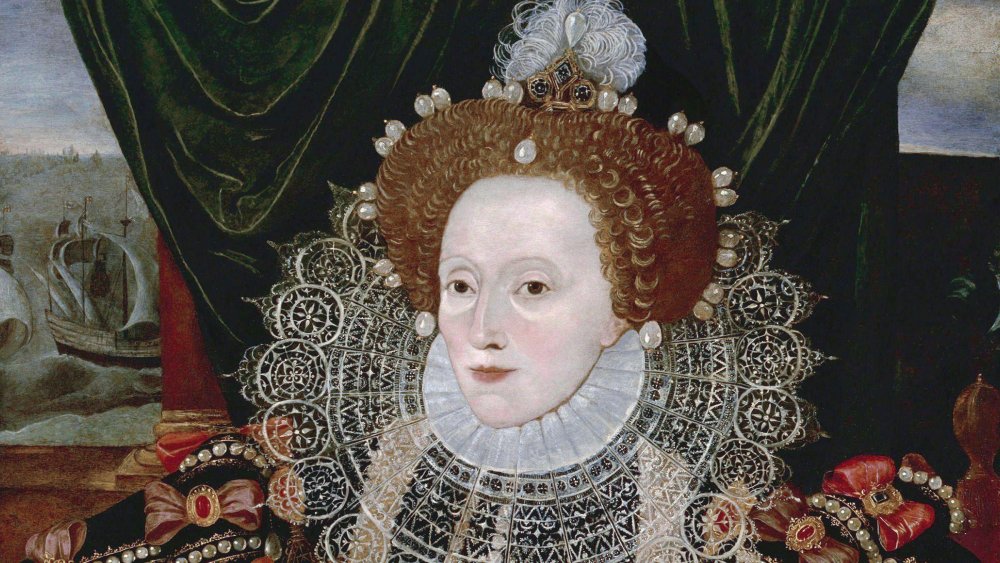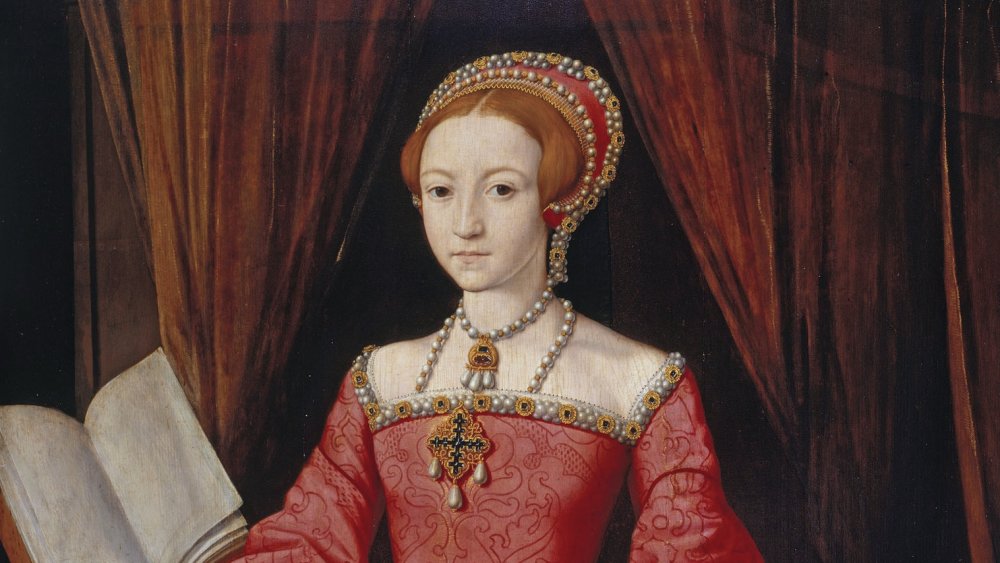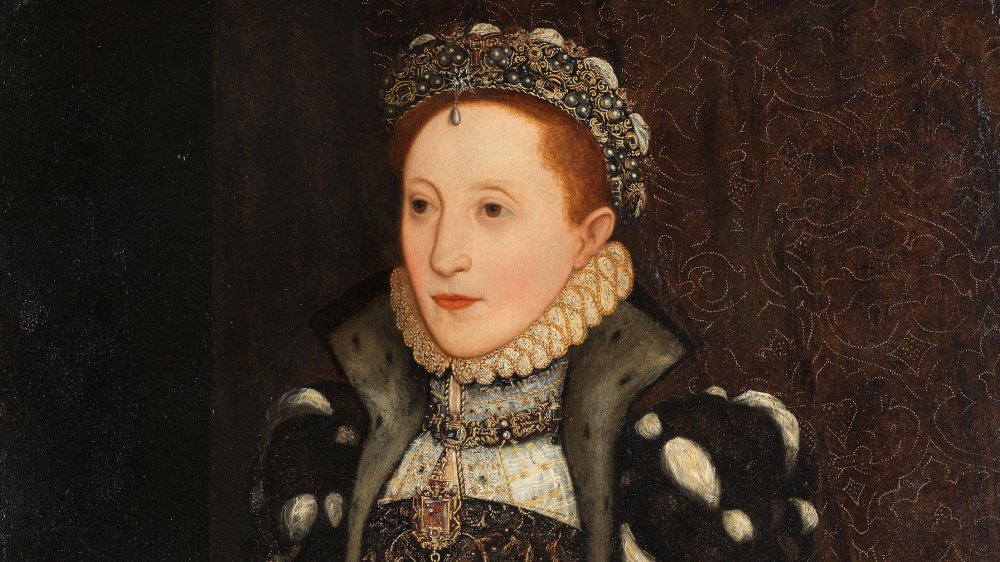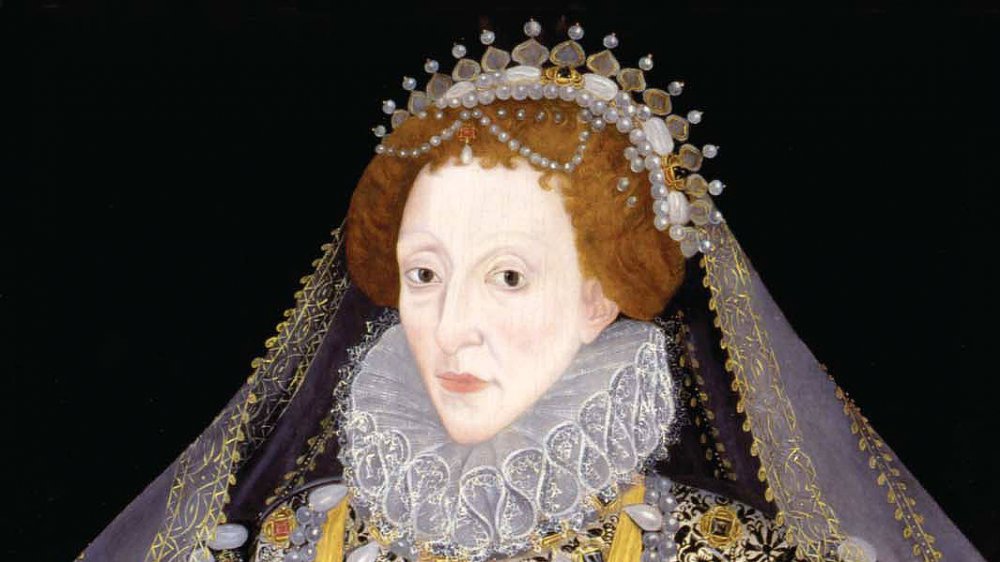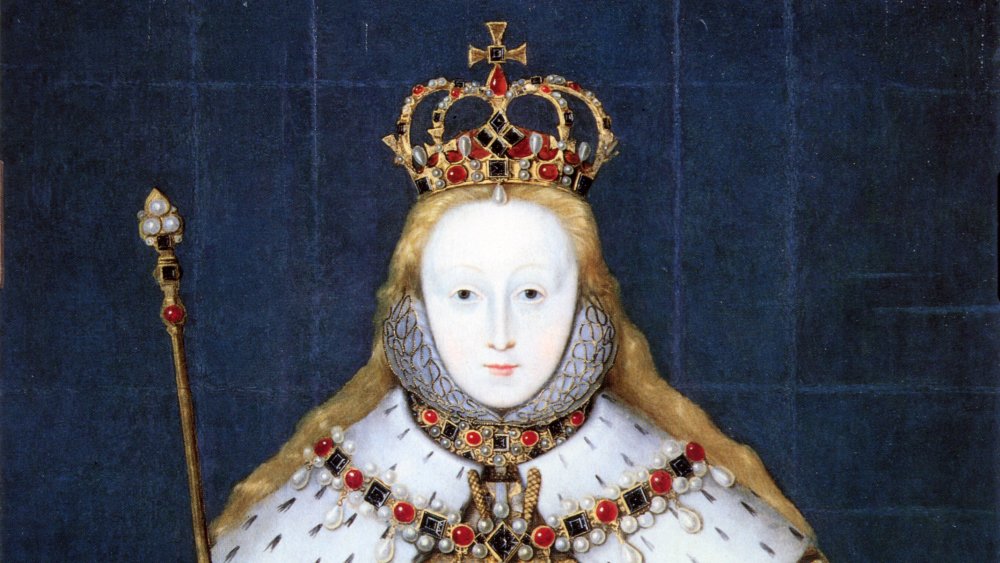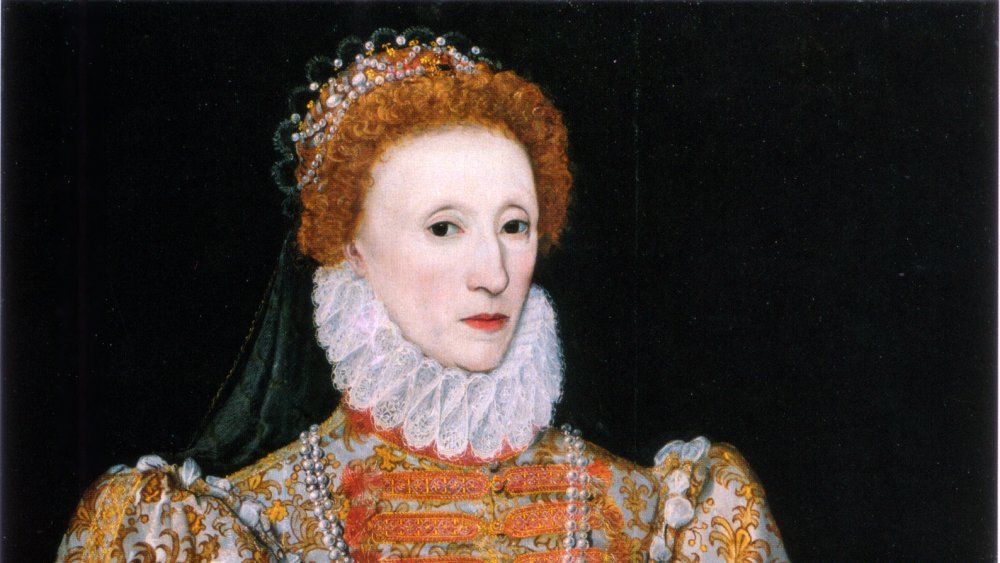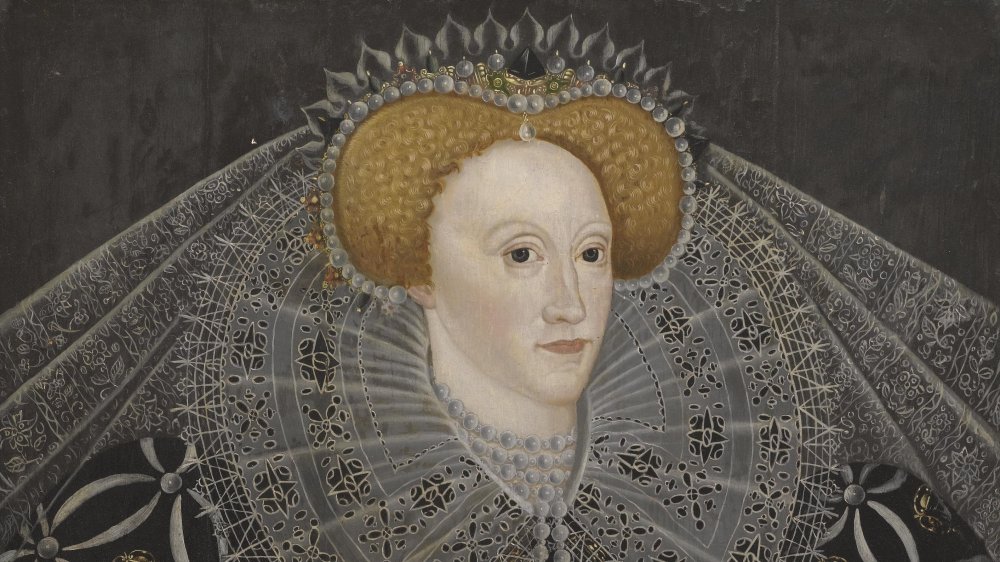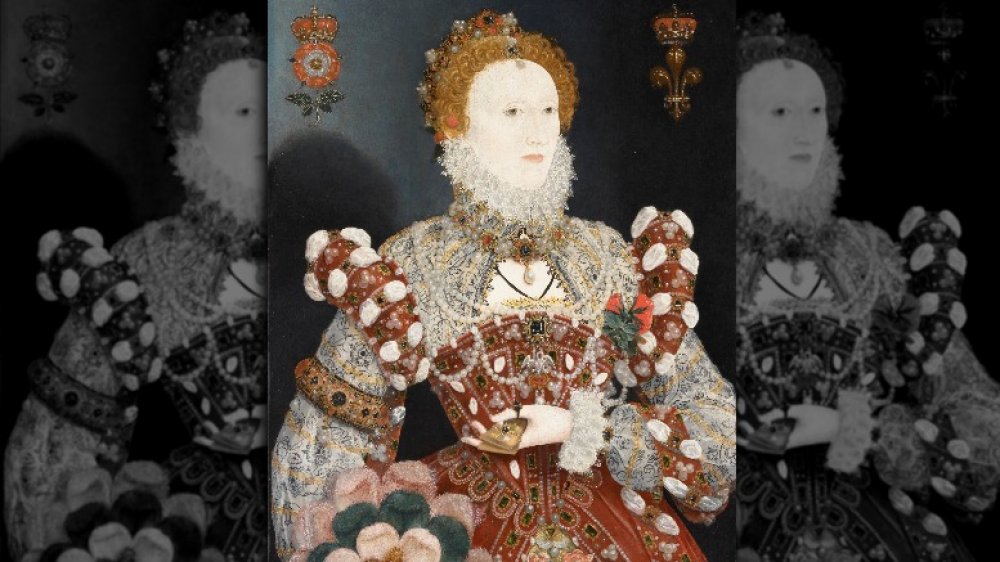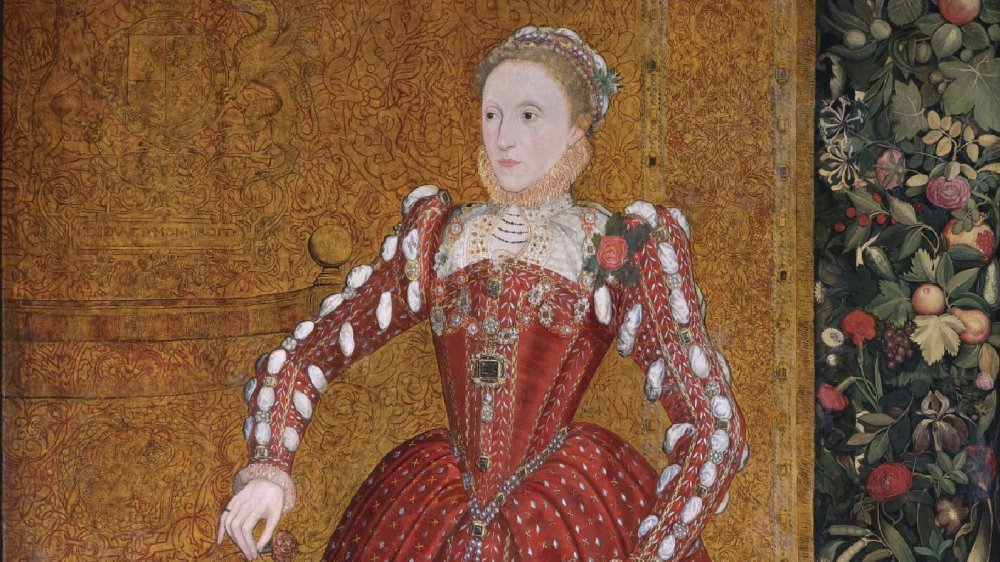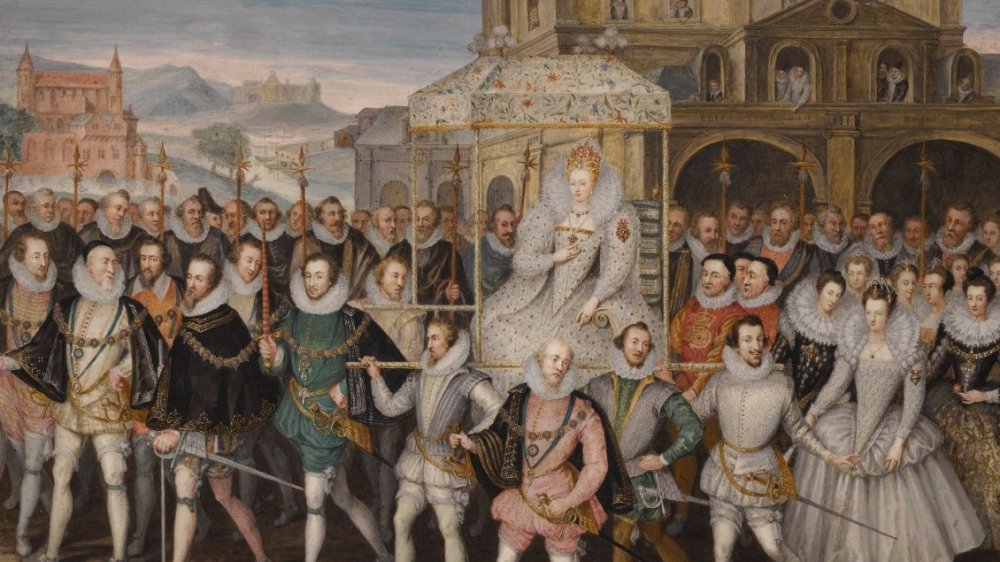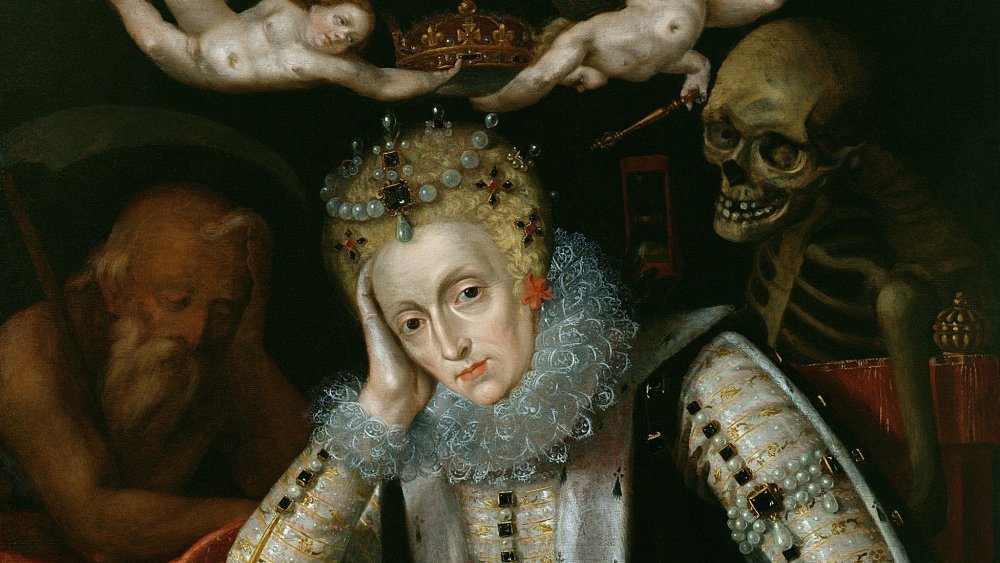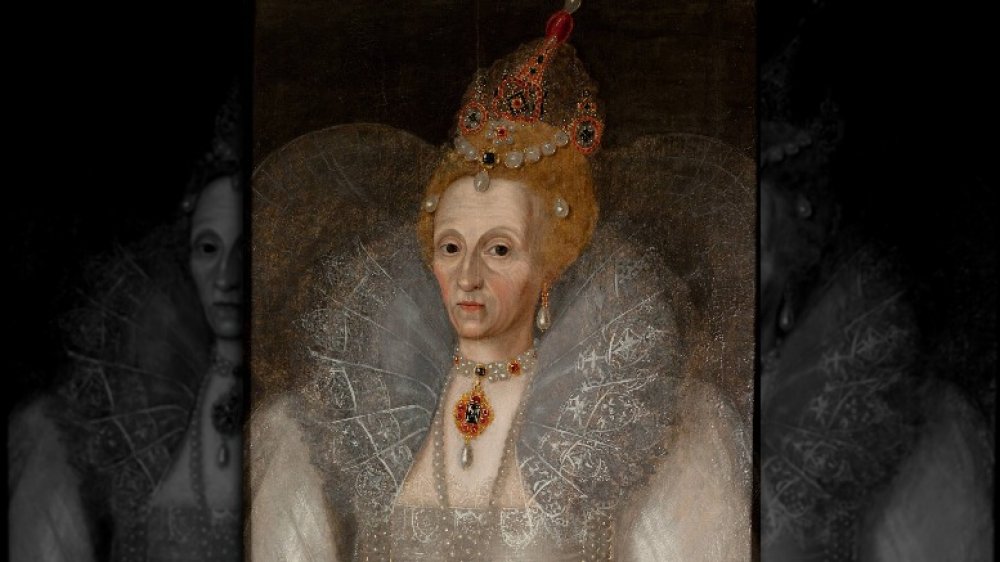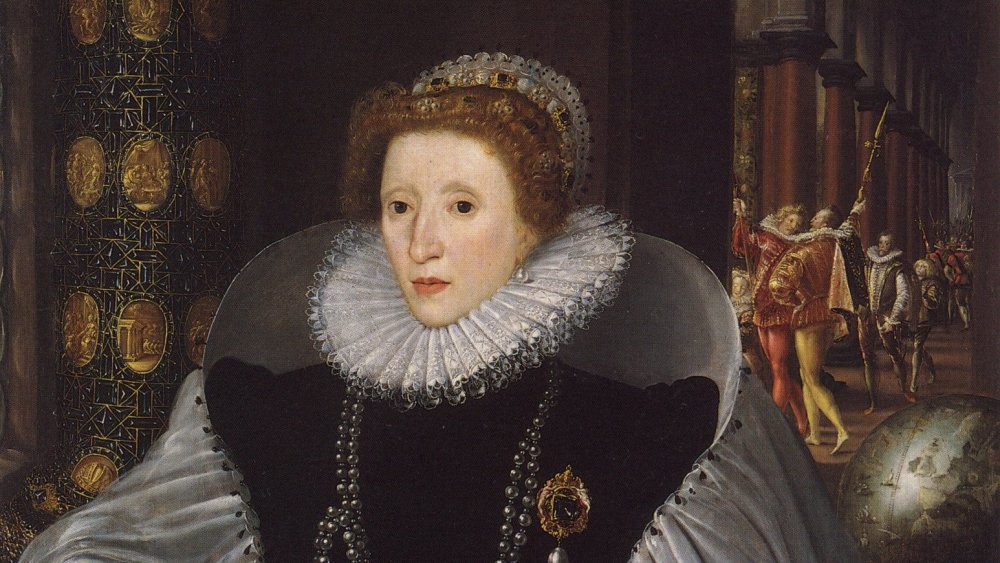The Truth About Queen Elizabeth I's Iconic Look
Being a queen used to be serious business. Modern ones have a lot on their plates, sure, but the pressures of cutting ribbons don't compare to what was happening 500 years ago. For Queen Elizabeth I, who took the throne of England in 1558 and ruled until 1603, her reign was a matter of life and death.
Elizabeth had to think very carefully about how she presented herself. Her power was tenuous thanks to her older half-sister, Mary I, and their father, Henry VIII. Dad had broken with the Catholic church when it wouldn't annul his marriage to Catherine of Aragon, Mary's mother. Henry wanted to marry courtier Anne Boleyn so badly that he created the protestant Church of England and got his divorce that way. Anne was executed in 1536 for treason, though really Henry wanted a new wife and a male heir. Anne had produced only Elizabeth. Henry eventually got his boy, Edward, who died not long after Henry. That left older sister Mary to inherit the throne and try to turn England back to Catholicism.
When Mary died, a 25-year-old Elizabeth became queen. She had to appear powerful in order to uphold her royal status and push back against the stereotype of a weak woman, alone and unfit to rule. Thus, the ornate gowns, the elaborate hairstyles, the jewels, and the white makeup meant to make her seem young and timeless all at once. For Elizabeth, looks were all about power.
Elizabeth was called "handsome" in her youth
Discussing a monarch's appearance was a dangerous move during the Tudor period. It was a time of great upheaval, beginning with Henry VIII's break with the Catholic Church in the 1530s, says History, and his subsequent revolving door of wives. After Henry passed in 1547, his young heir, Edward VI, quickly followed him into death in 1553. The kingdom was thrown into further turmoil over the succession, as Henry had only daughters, and the prospect of a woman on the throne daunted patriarchal Tudor society.
Henry's eldest daughter, Mary, eventually took the throne and became the first queen to rule England in her own right. However, she was a dedicated Catholic who went about persecuting Protestants in her realm so harshly that she earned the nickname "Bloody Mary," says History.
According to Biography, Elizabeth was only 25 when she became queen in 1558. Prior to this, visitors to court described the young Princess Elizabeth as "handsome" or "comely," says Historic UK, though no one seems to dive fully into flattery by calling her beautiful. They noted her tall stature and reddish-gold hair, which would become something of a signature look even as Elizabeth aged.
Smallpox scarred Queen Elizabeth's face
Only four years into her reign, 29-year-old Elizabeth almost died. At first, writes The Tudor Society, those around her assumed that it was merely a rough cold. Perhaps, knowing all of the different diseases that could kill royals and commoners alike, they were thinking wishfully. Then, the queen's fever worsened, and she began to show the telltale signs of smallpox. She survived but was left with "pocks," or small scars, on her face for the rest of her life.
One female attendant who nursed her through the illness, Mary Sidney, also came down with smallpox. Though she also survived, Sidney's scars were far worse. Her husband, Henry, wrote that "I left her a full faire Lady [...] and when I returned, I found her as foul a lady as the smallpox could make her." Lady Mary never made a public appearance at court ever again.
Though Elizabeth got off relatively lightly compared to poor Mary Sidney, she still felt that she had to manage her smallpox scars. That may be why she eventually resorted to using makeup, says History Extra, though that move might have been worse than simply accepting her scars. The lead in her white foundation was toxic and almost certainly left her with gray, wrinkled skin after years of use.
Queen Elizabeth's white makeup was dangerous
As she aged, Elizabeth is said to have used more and more makeup to maintain the appearance of a young, strong queen, says BBC's History Extra. She may have also used heavy white makeup to cover smallpox scars, which could leave survivors with distinct markings all over their face and body.
Yet, that makeup could very well have made things worse for the queen as she aged. The white makeup that was popular in her time, often called "Venetian ceruse," was full of lead. Though us modern folks know to keep lead off of our faces, people throughout history weren't so well-informed. According to National Geographic, lead has been a cosmetic ingredient since at least ancient Egypt, where eye makeup was composed partly of lead salts. While Elizabeth may have liked the initial look of her Venetian ceruse, as it smoothed out her smallpox scars, she probably wasn't happy with its long-term effects. White lead makeup has been linked to skin discoloration, hair loss, breathing problems, and even tooth decay, says Face Paint: The Story of Makeup.
Other parts of the queen's makeup kit were just as dangerous. Red pigment, used in blush and lip color, contained mercuric sulphide. Over time, mercury poisoning can affect a person's neurological function, leading to symptoms like memory loss, slurred speech, and depression.
Queen Elizabeth's look was really about securing the throne
For Queen Elizabeth, appearing as a glorious symbol meant that she had to reinforce the impression that she was not just young but upper-class. That's where the white face paint came in, says Slate. The thought went that while lower-class women were outside working and getting a tan, royals would be inside. The desire for fair skin represented a class divide, rather than a racial one, but it marked an important divide for Elizabeth all the same.
Elizabeth had to convince people that she was a true royal, even though history made things awkward. Royal Museums Greenwich says that Henry, her tempestuous father, had declared her illegitimate after executing her mother, Anne Boleyn. Elizabeth was put back into the line of succession, but it was in her best interest to appear as royal as possible in case anyone changed their mind. She had to shore up the validity of her royal glory and high class through fancy dresses and pale face paint.
In private, things were different. When Elizabeth didn't have to worry about impressing anyone, says The Life of Elizabeth I, she dressed plainly. Some even claimed that she once wore the same unadorned black dress for three days straight. It's clear that all of the fine fabrics and jewels in her portraits were really just her work uniform.
Some fashion gifts might have been an attempt to kill Elizabeth
Much of Elizabeth's reign was soured by political intrigue and concerns about assassination. She was the subject of multiple attempts on her life, according to The National Archives. These include the 1571 Ridolfi Plot and the 1583 Throckmorton Plot, both of which tried to replace Elizabeth with her Catholic cousin, Mary, Queen of Scots. Elizabeth, who was reluctant to strike against another royal, wouldn't admit that her cousin was a serious liability until the Babington Plot of 1586. That treachery ultimately led to Mary's imprisonment and execution.
Most of these plots were uncovered through poorly concealed letters or loose-lipped conspirators. That didn't preclude other methods undertaken to kill the queen, however. Anything and anyone could be suspected of having murderous intent. For much of Elizabeth's reign, she and her closest advisers were subject to intense and sometimes very earned paranoia. Some people really were out to get her.
It got so bad that William Cecil, her secretary of state, forbade her from accepting gifts like gloves and detachable sleeves. They could be poisoned, he argued. According to The Royal Art of Poison, her wardrobe was also closely guarded. Even her underwear was carefully inspected by Elizabeth's ladies-in-waiting. In some instances, they were told to act as upper-class guinea pigs, testing perfumes and fabrics against their own skin before handing them over to the queen.
Queen Elizabeth didn't take kindly to fashion rivals
Though sources like The Life of Elizabeth I state that the private Elizabeth wore plain dresses, her public persona was very different. She was the Virgin Queen, after all, a glittering, awe-inspiring picture of a rightful ruler of England. Elizabeth needed to look the part, with richly decorated dresses, the finest lace, and the illusion of strength and youth even as she aged.
This also meant that anyone who appeared finer than Elizabeth could face consequences. While Elizabeth never went so far as to threaten bodily harm to anyone showing her up, she could still embarrass them mightily.
As related in The Life of Elizabeth I, the queen's ladies-in-waiting were to dress simply in black or white. That way, Elizabeth, in her elaborate gowns, would stand out all the better as a semi-divine royal. Only, Lady Mary Howard didn't seem to get the memo. On one occasion, she foolishly showed up in a very nice dress that caught the queen's eye. Elizabeth tried it on without bothering to get Lady Mary's permission and then declared that it was too short for her royal body, anyway. She told Lady Mary that it was "too fine" to wear in the queen's presence. The younger woman was obliged to put the expensive dress away for years, until Elizabeth passed away in 1603.
Queen Elizabeth probably didn't look like a clown
If retellings of Elizabeth's reign are taken at face value, you might think that the queen looked rather ridiculous. She's often shown with a ghoulishly white face and body draped in jewels, while a curled red wig sits on top of her head. Sometimes, she looks like a Tudor Ronald McDonald.
She probably didn't look quite so bad. According to The Life of Elizabeth I, Elizabeth actually preferred to wear simple gowns when she wasn't supposed to show off her finery in court. Her ladies-in-waiting, who provided many of these accounts, would have spent quite a lot of time with the queen in intimate settings. They certainly never reported that the queen slapped on the white face paint when she was relaxing in private.
Also, it's worth considering the fact that no one really wanted to overdo it. In The Face of Queenship, it's clear that even women who were all in on wearing makeup tended to do so with a light hand. And, if you're, say, a Catholic pamphlet writer who wants to undermine the Protestant queen, wouldn't you give your argument a bit more oomph by saying she looks like a ridiculous Jezebel?
Elizabeth, who had to walk that very fine line between presenting herself as a young, powerful ruler and also as an appealing woman, probably wouldn't have had inch-thick clown makeup covering her face.
Queen Elizabeth's look was also about religion
As a Protestant monarch, Elizabeth dealt with serious tensions between Catholic and Protestant Christians in England. Her older sister, who reigned as Mary I from 1553 to 1558, says Britannica, was devoted to bringing Catholicism back to England after the rebellion of their father, Henry VIII. She was so intense that she earned the nickname "Bloody Mary" for her persecution of Protestants.
Elizabeth presented herself as a Protestant. This pleased the anti-Catholic set but naturally angered English Catholics. Though they could practice more openly than before, Catholics in England were still in an awkward position after Elizabeth's father broke with the Church and forced England to drop the crucifixes and monasteries as it became officially Protestant.
Some of the worst tactics, says Images of a Queen, came courtesy of the pamphleteers. These printers created cheap, quickly made material that spread rumors and slander about whomever had most offended the printer. Think of them like the gossip magazines of their day, without the fear of libel laws.
Pro-Catholic poems published in these pamphlets compared Elizabeth to Jezebel, a Biblical queen who was best known for her ridiculous adornments and utter cruelty. Elizabeth's execution of Mary, Queen of Scots in 1587 heightened the discourse. Pro-Catholic agitators, says Queen Elizabeth I, said that she was an extravagant, licentious lover of sensuality and power, embodied by her own dramatic way of dressing in public.
Queen Elizabeth's fashion walked a gendered tightrope
Elizabeth was supposed to pretend she would be forever youthful, strong, and fit to rule. As a woman, that often meant playing into stereotypes of her day about how women were expected to present themselves.
As an unmarried woman, says Slate, Elizabeth found herself in an extra-complicated situation. She refused to marry and potentially cede her power to a man, regardless of whether he was English or foreign, common or royal. But that meant she had to fight back against common misconceptions of her time about women, namely that they were supposedly weak in mind and body. Elizabeth eventually became the figurehead of a "cult of Elizabeth," the much-vaunted and almost holy "Virgin Queen" who would, for her supporters, remain strong and feminine for the duration of her reign.
Sometimes, presenting herself as a powerful ruler meant pushing back a bit against the gendered dress of her day. In her 1588 speech to English soldiers at Tilbury, who were waiting to fight back against the Spanish Armada's attempted invasion of Britain, Elizabeth mixed different genders of clothing. According to The Tudor Society, accounts of the time state that she wore a dress but then also accessorized with bits of armor and weaponry more associated with military might. It may have been unusual for a woman walking down a street, but it was apparently just right for a ruler addressing her troops before battle.
Don't ask the queen about her teeth
Contrary to popular belief, most people in Tudor and Elizabethan England were keen on keeping their bodies clean as best as they could. According to The New Republic, people may not have bathed daily, but they did frequently change their underclothes and try to wipe themselves down with linen cloths.
History Extra reports that Tudors, like other people throughout history, really did try to take care of their teeth, though with limited tools. For dental care, some attempted to brush their teeth with frayed twigs or rags. They also might have used acids like vinegar or wine as a sort of mouthwash or breath freshener.
If people were at least attempting to preserve their dental health, then why did the queen suffer from such bad teeth? This is one aspect of her presentation that isn't subject to a lot of propaganda. Visitors to the court wrote that her teeth were visibly discolored toward the end of her reign. According to Royal Museums Greenwich, some went so far as to say that the old queen's teeth had turned black.
It was probably due to the sugar in her diet. Most lower- and middle-class Tudors actually had pretty decent teeth, says Quartz, because they simply didn't have access to a lot of sweet stuff. As a royal, however, Elizabeth would have had regular access to sugar, which she reportedly enjoyed in all manner of treats.
Elizabeth's portrait painters were part of a complex propaganda scheme
As her reign progressed, Elizabeth became increasingly aware of just how important portraiture was to shoring up her image. According to British Heritage, Sir Robert Cecil, her secretary of state, said that none of the many painters who had completed a portrait of the queen presented her with work up to her standard. "Therefore Her Majesty commands all manner of persons to stop doing portraits of her until a clever painter has finished one which all other painters can copy. Her Majesty, in the meantime, forbids the showing of any portraits which are ugly until they are improved."
Harsh, to be sure, but Elizabeth's concern wasn't mere vanity. She would endure numerous attacks on her looks, her ability to rule, and even multiple plots centered on her own death. In 1601, she had to watch as one of her favorites, the Earl of Essex, stupidly tried to foment open rebellion against her. As Royal Museums Greenwich reports, he was quickly captured and executed, but it was still yet another blow to the queen's long-damaged sense of security.
In a world where many of her subjects would only see her briefly, or simply as a figure in a portrait, image was everything for Elizabeth. As the National Portrait Gallery shows, nearly every work showing the queen, monumental or miniature, was created specifically to show that she had the looks and the power to rule.
Queen Elizabeth wore a ring with a secret portrait hidden inside
At the time of her death, Elizabeth was in pretty rough shape. The 69-year-old queen, who had reigned for 45 years, was weak and aged. Her teeth were rotten. The white makeup, which Royal Museums Greenwich maintains was an inch thick on her face, according to some accounts, may have contained enough lead to poison her. But, since Elizabeth had refused to give permission for an autopsy, no such procedure took place. The true cause of her death, whether it was lead poisoning, respiratory disease, cancer, or something else, remains a mystery.
At the time of her death, Elizabeth wore an ornate ring with two hidden portraits inside. One was of herself, but the other was of a different woman. Some believe that it's her mother, the executed Anne Boleyn, as The Guardian reports. Others, says the Irish Examiner, argue that it is Catherine Parr, her last stepmother. Parr and Elizabeth had a close relationship, to the point where Elizabeth stayed with Catherine and her new husband after Henry VIII's death. Whoever the other woman is, the ring provides a glimpse into Elizabeth's inner world, locked away from the conspicuous glitz and glory of the rest of her look.
